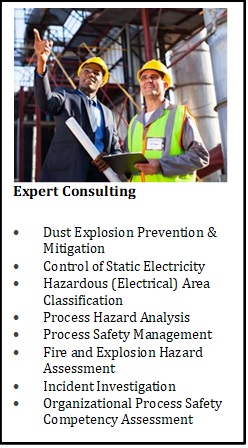Search
Electrical Area Classification OR Hazardous Area Classification?

Our process safety consultants see many things, good and less good, as they go about their business of making industrial processes safer. One rightly proud client was explaining the details of his Electrical Area Classification work, showing layered drawings for Class I (liquids) and Class II (dusts) with appropriate designation of divisions and assignment of gas and powder groups. In walking through the facility, though, we observed an operator pouring a fine powder from a plastic-lined fibreboard drum into a vessel containing toluene; a Class I div 1 surrounded by a class 1 div 2 AND a Class II div 1 overlaid area. Anyone spot the issue here?
[Risk of electrostatic discharges from the plastic liner, drum, and operator in presence of a hybrid flammable vapor/ dust atmosphere]
So why not make more use of your Hazardous Classified Locations in broader hazard analysis work?
Originally, Hazardous Classified Locations were established to provide a systematic way that process industries would determine where they could have flammable atmospheres present and how likely (how often) those flammable atmospheres were to be found there. This would then be used for the selection of the correct/safe type of electrical equipment. It all began with consideration of the vapors of flammable liquids but was eventually broadened to include flammable and combustible dusts. Afterall, powders can get inside electrical equipment too – and can build-up on warm/hot equipment surfaces and wind up being a fire and explosion hazard.
This formalized area classification has allowed the process industries to make the correct location-dependent choice of electrical equipment and to how to install it – and so prevent electrical ignition of gases, vapor, dust and fibre-laden flammable atmospheres [Class I, Class II and Class III according to NFPA 70/ NEC in North America] – but here’s the point….
…clearly, electrical arcs and sparks are not the only sources of ignition to be found on process plant. How about the electrostatic ‘sparks’ in the following examples:
- Safe Use of Flexible Intermediate Bulk Containers (FIBCs) – Requirements of NFPA 652
- Electrostatic Hazards: Early Warning Signs
or impact and friction sparks, or overheated bearings, or sticking/ rubbing conveyor belts, or hot work or….
Indeed, NFPA 30 requires those companies engaged with the storage, processing, handling and use of flammable substances (gases, vapors, combustible dusts, hybrid mixtures….) to take precautions that prevent the ignition by ALL sources of ignition. Our point is that although many companies will determine Hazardous Area Classification of their facilities (and we sometimes do this for them) and indeed install and maintain appropriately rated electrical equipment in those areas, they are less effective at assessing, identifying and controlling other potential sources of ignition. A good Hazardous area classification provides an excellent starting point and guide as to where to look to find and control those other potential sources of ignition; A good starting point for any operational hazard and risk assessment.
Hazardous Area Classification
As you may know, Hazardous Area Classification is all about identifying potential sources of liquid, vapor, gas, and dust releases, under both normal and abnormal conditions. It’s about estimating the likelihood, quantity and duration of leakage or releases and about determining the effectiveness of ventilation. It’s also about considering any release/leakage due to repair and maintenance operations and about assessing the probability of flammable mixture transmission by trenches, pipes, conduits, ducts and so on in the vicinity.
Armed with all of this, Hazardous Area Classification is then about using the proper guidelines (reference below) to assign a Class and Division around each release point and the areas affected by the release. Documentation of the classification is then mandated which is then used with knowledge of the ignition characteristics of the likely gases & vapors and dusts to be found in those areas (given by gas and dust groups A to G) to ensure the correct choice of electrical equipment and installation.
But all this information is, of course, highly relevant to any fire and explosion hazard assessment of the same areas. Flammable vapor atmospheres of even common solvents such as ethanol and methanol – Group D gases – will be very susceptible to certain ignition sources such as static electricity or impact sparks. On the other hand, a group G powder such as wood, sugar or starch will – relatively speaking – not be as sensitive to certain types of static discharges that can readily ignite solvent vapors. And if you need to have plastic bags or containers on your plant, ensure they are not able to give rise to discharges that can ignite any flammable vapor or dust cloud atmospheres that might be present when the plastic is being used.
It’s all in the name: Electrical Area Classification OR Hazardous Area Classification.
These 2 names are readily interchangeable. Perhaps Electrical Area Classification is a hangover from the origins of purpose – to prevent ignition of flammable atmospheres by electrical equipment. We prefer the name Hazardous Area Classification for the reasons explained in this article. At Stonehouse Process Safety, our consultants therefore spend their time conducting Hazardous Area Classification for our clients. But whatever we or others call it, we will always be sure to explain the wider use of the Area Classification work and indeed, when we are undertaking our wider hazard studies on clients’ facilities, an up-to-date Hazardous Area Classification, always makes an excellent starting point.
Don’t ignore it.
Some relevant references on Hazardous Area Classification:
NFPA 30 – Flammable and Combustible Liquids Code
NFPA 70 – National Electrical Code
NFPA 496 – Standard for Purged and Pressurized Enclosures for Electrical Equipment
NFPA 497 – re Classification of Flammable Locations for Electrical Installations in Chemical Process Areas
NFPA 499 – Recommended Practice for the Classification of Combustible Dusts and of Hazardous (Classified) Locations for Electrical Installations in Chemical Process Areas

Get in touch
To learn more about our expertise and services in dust explosion prevention & mitigation, call us at +1 609 455 0001 or email us at [email protected] today.
We also offer tailored virtual and in-company process safety training programs on Dust Explosions, Static Electricity and HAC (Hazardous Area Classification) and more. Find further information here.











